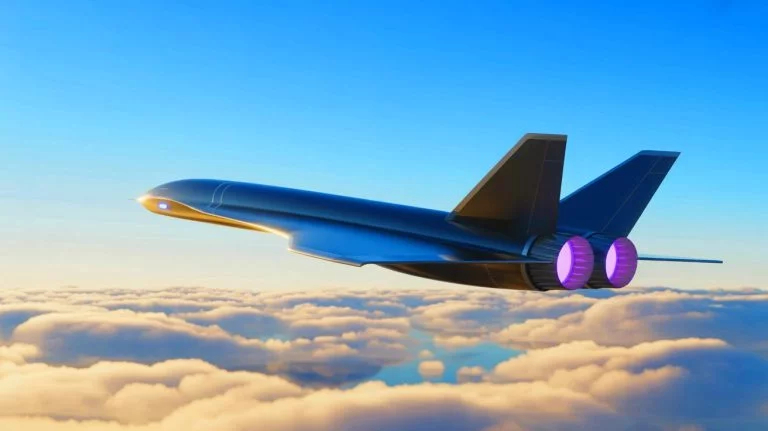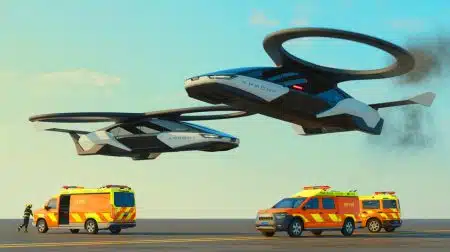| IN A NUTSHELL |
|
In a striking new development, GE Aerospace has ignited speculation with the release of a video hinting at the creation of a groundbreaking hypersonic aircraft. The video, showcasing a conceptual rendering powered by dual-mode ramjet engines, has drawn significant attention. Industry insiders are abuzz, considering the potential of this aircraft to surpass the legendary SR-71 Blackbird. This storied aircraft was a marvel of its time, known for its incredible speed and reconnaissance capabilities. As GE Aerospace teases what could be a new era in aviation technology, the aerospace community and military enthusiasts alike are keenly watching to see if these ambitious plans will come to fruition.
GE Aerospace’s Hypersonic Capabilities
GE Aerospace’s recent video, released on July 28, has stirred conversations across the aviation sector. The teaser, marked by the slogan “everything seems impossible…until it isn’t,” suggests that GE is working on a significant new project. Although details remain scarce, the video has fueled speculation that GE might be poised to develop a successor to the iconic SR-71 Blackbird.
The SR-71 Blackbird, developed by Lockheed Martin, was a strategic reconnaissance aircraft that achieved speeds of Mach 3. Its legacy as a pioneering model of aviation set high standards for future aircraft. Lockheed Martin is currently working on the SR-72, a potential successor to the Blackbird. However, with GE’s expertise in hypersonics, particularly their dual-mode ramjet engine, the company might be positioning itself as a formidable contender in this field.
GE’s dual-mode ramjet engine, first demonstrated in 2024, utilizes an advanced technology known as rotating detonation combustion (RDC). This technology enhances fuel efficiency and thrust generation, making it a groundbreaking innovation in engine design. Unlike traditional engines, RDC leverages a detonation wave that travels around an annular chamber. According to GE Aerospace, this engine can reach speeds exceeding Mach 10, suggesting a dramatic leap in performance over the SR-71’s capabilities.
A Spiritual Successor to the SR-71 Blackbird
The SR-71 Blackbird was renowned for operating at altitudes above 85,000 feet and reaching speeds of Mach 3.2. These attributes made it an unparalleled reconnaissance aircraft during its operational years from 1966 to 1990, with a brief reactivation from 1995 to 1998. The aircraft’s ability to outpace missiles of its era underscored its strategic importance.
Today’s aerospace landscape is vastly different, with hypersonic missiles that exceed speeds of Mach 5, surpassing 3,800 mph. This presents a challenge for any new aircraft aiming to replicate or surpass the SR-71’s capabilities. Lockheed Martin’s SR-72, dubbed the “Son of Blackbird,” is a leading effort in this arena. Developed by the company’s Skunk Works division, the SR-72 will utilize a turbine-based combined cycle engine, integrating a turbofan for subsonic and supersonic flight and a scramjet for hypersonic speeds. This configuration promises seamless transitions between flight modes, promising to redefine aerial reconnaissance when it enters service in the 2030s.
Rumors suggest that GE Aerospace may soon announce its own SR-71 successor, potentially redefining the competitive landscape in hypersonic aviation.
Technological Innovations in Hypersonic Flight
The pursuit of hypersonic flight has captivated engineers and scientists for decades. The potential to travel at speeds exceeding Mach 5 opens new possibilities in both military and civilian aviation. Key to these advancements are innovations in propulsion systems, materials, and aerodynamics.
GE Aerospace’s dual-mode ramjet engine represents a significant leap forward in propulsion technology. By utilizing rotating detonation combustion, this engine type maximizes efficiency and thrust. This advancement is crucial for achieving sustained hypersonic speeds, enabling potential new aircraft to operate effectively in high-speed environments.
Moreover, advances in materials science are critical for withstanding the extreme temperatures and pressures experienced during hypersonic flight. Engineers are exploring new alloys and composites that can endure such conditions without compromising structural integrity. These innovations are pivotal as aerospace companies race to develop the next generation of high-speed aircraft.
The Strategic Implications of Hypersonic Aircraft
The development of hypersonic aircraft carries significant strategic implications. Such aircraft promise to revolutionize reconnaissance, strike capabilities, and transportation. For the military, the ability to conduct rapid surveillance or deliver precision strikes at unprecedented speeds offers a tactical advantage.
Beyond military applications, hypersonic technology holds promise for commercial aviation. The prospect of drastically reducing travel time between continents is an enticing possibility. However, the challenges of cost, safety, and regulatory approval remain significant hurdles.
As GE Aerospace and other companies pursue these innovations, the geopolitical landscape may shift. Nations with advanced hypersonic capabilities could leverage these technologies to exert greater influence on the global stage. The race to develop and deploy hypersonic aircraft is not just a technological endeavor but a strategic one with far-reaching consequences.
As GE Aerospace’s hypersonic ambitions continue to unfold, the aviation world watches closely. The potential for a new era of high-speed flight is tantalizing, with implications that extend beyond the realm of aviation. As developments continue, one question remains: How will these advancements shape the future of global aviation and defense strategies?
Did you like it? 4.4/5 (24)






Wow, Mach 10? That’s insane! 🚀 How soon can we expect to see this in action?
Is this just another hype or a real game-changer? 🤔
Can we trust GE Aerospace to pull this off, given their track record?
Seems like science fiction is becoming reality! Can’t wait! 😍
What does this mean for global security? Are we entering a new arms race?
Isn’t it ironic that we’re still using planes when teleporting should be a thing by now? 😂
Thanks for the article, but I wish there were more technical details.
Does anyone else think this will just lead to more military spending? 🤑
How does this compare to China’s hypersonic capabilities?
Can’t wait to see how this tech trickles down to commercial use! ✈️
Hope the environment isn’t paying the price for this “innovation”. 🌍
So, we’re going faster but still can’t get decent in-flight Wi-Fi? Priorities! 📶
What’s the fuel efficiency like on this hypersonic beast?
Who else is feeling nostalgic about the SR-71 Blackbird after reading this? ❤️
Could this technology be used for civilian travel, or is it strictly military?
Why isn’t this making bigger headlines? This is huge news!
Because it is just a concept.
It hasnt left the drawings stage.
Companies around the world design many concept aircraft.
Its only headline worthy when a prototype is tested. In this case that’ll be 2030 ( earliest).
Is it just me, or does “rotating detonation combustion” sound like something out of a superhero movie? 😆
How will this affect the balance of power globally?
Would love to see a comparison chart of the SR-71 vs this new hypersonic plane. 📊
Can someone explain how “dual-mode ramjet engines” work in layman’s terms? 🤔
Isn’t it a bit scary to think about how fast military tech is advancing? 😨
Seems like GE Aerospace is trying to outdo Lockheed Martin. Competition is good! 💪
How sure are we that this isn’t just a PR stunt?
With all these advances, why can’t we just have flying cars already? 🚗✈️
Great article, but I’m still skeptical until I see it fly.
Would this aircraft be able to evade modern missile systems?
Is this really necessary or just a flex of technological might?
Seems like the future is now, but are we truly ready for it?
Is there any info on how much this project is costing taxpayers?
Does anybody else miss the simpler days of aviation? 🕊️
How far are we from seeing this tech in commercial airlines?
Hope this doesn’t lead to more conflict rather than peace. 🕊️
Isn’t Mach 10 a bit overkill? Do we really need to go that fast?
Can’t wait for the documentary on how they built this thing!
What are the chances this ends up being a Hollywood blockbuster plot? 🎬
Thanks for the insight! Looking forward to seeing how this unfolds. 😊